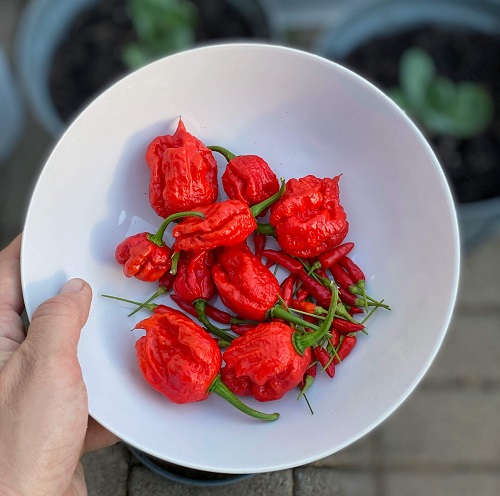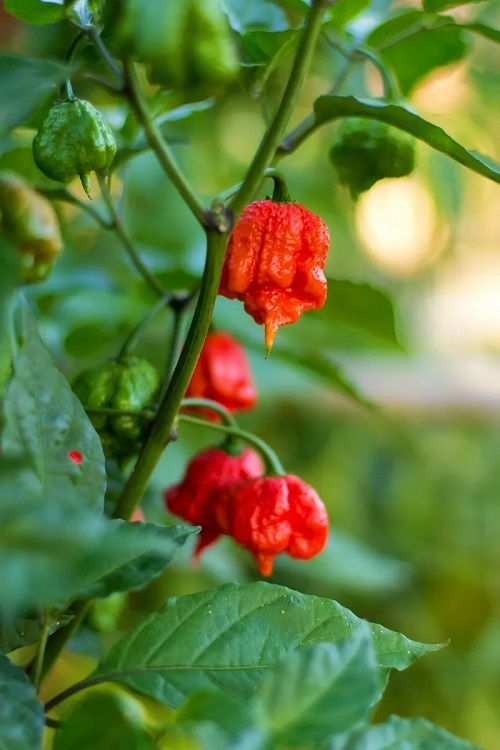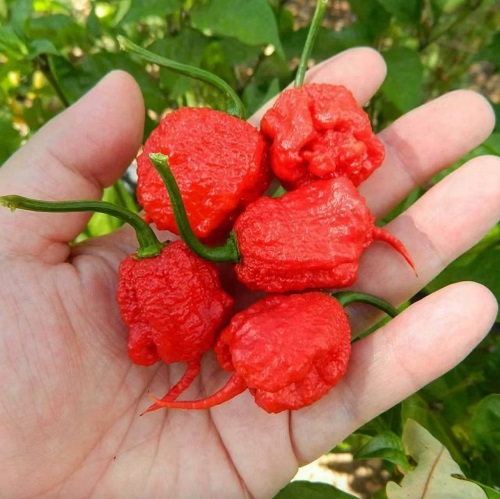Carolina Reaper shines on top when it comes to the hotness in pepper world! Here’s everything you need to know about growing it.
Explore the fiery world of Carolina Reaper, the hottest pepper on Earth. Learn the art of cultivating this intense chili with our expert guide, from sowing seeds to reaping the heat. Discover the secrets to successful growth and harness the power of this ultimate spicy experience.
Read our Article on How To Grow Chili Peppers In Pots here
Carolina Reaper Information
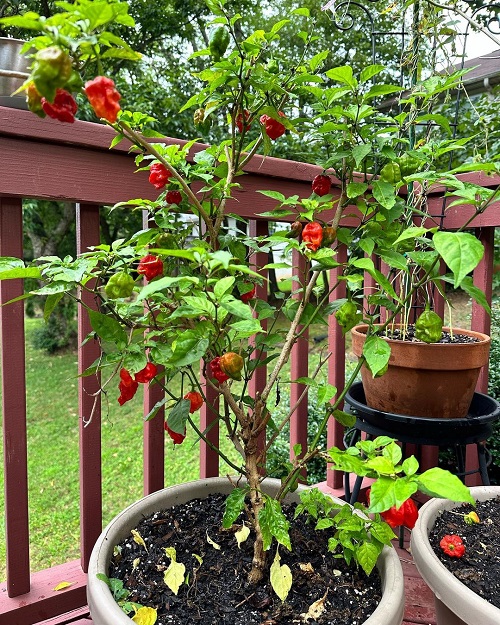
The Carolina Reaper (Capsicum chinense ‘Carolina Reaper’) holds the title of the world’s hottest chili pepper, renowned for its fiery heat and distinctive appearance. From its origins to its impact on the culinary world, this guide explores the fascinating story behind the Carolina Reaper.
1. Origin and Invention
Birthplace
- Location: The Carolina Reaper was bred in South Carolina, USA, by Ed Currie of the PuckerButt Pepper Company.
Creation
- Breeding: Ed Currie aimed to create a pepper with extreme heat, combining a Pakistani Naga pepper and a Red Habanero pepper.
- Crossbreeding: The Carolina Reaper resulted from several generations of selective crossbreeding to intensify the heat.
2. Characteristics and Scoville Heat Units (SHU)
Appearance
- Shape: The Carolina Reaper has a unique wrinkled and bumpy exterior, resembling a sinister-looking red pod.
- Size: The peppers are generally small to medium-sized, ranging from about 1 to 2 inches in length.
Heat Level
Scoville Heat Units (SHU): The Carolina Reaper’s SHU can range from 1.6 million to over 2.2 million, making it exceptionally hot.
3. Culinary Use
Heat: The intense heat of the Carolina Reaper is not for the faint of heart, making it a sought-after ingredient for enthusiasts of spicy cuisine.
Flavor: Beyond its heat, the pepper boasts fruity and slightly sweet undertones that add depth to dishes.
4. Popularity and Challenges
Guinness World Record: In 2013, the Carolina Reaper was officially recognized by the Guinness World Records as the world’s hottest chili pepper.
Warning: Due to its extreme heat, handling and consuming the Carolina Reaper requires caution and attention to safety.
Read Cordyline Hot Pepper Plant Information and Landscaping Uses here
Propagating Carolina Reaper
Yes, you can propagate Carolina Reaper peppers at home through various methods. Whether you’re a gardening enthusiast or a spicy food lover, growing your own Carolina Reapers can be a rewarding experience. Let’s explore different propagation methods that you can try in your garden.
1. Seeds
Collecting Seeds
- Harvest: Allow ripe Carolina Reaper peppers to fully mature on the plant. They should be bright red and fully developed.
- Extraction: Cut the peppers open and carefully remove the seeds from the placenta, which is the white part inside the pepper.
Planting Seeds
- Starting Indoors: Plant the seeds indoors in seed trays or small pots filled with seed starting mix. Plant them about 1/4 inch deep.
- Germination: Maintain warmth and moisture to encourage germination. It may take 1 to 3 weeks for the seeds to sprout.
Transplanting
- Timing: Transplant seedlings outdoors after the last frost date has passed and the weather is consistently warm.
- Spacing: Space the plants about 2 to 3 feet apart to allow for healthy growth.
2. Cuttings
Taking Cuttings
- Selecting a Plant: Choose a healthy Carolina Reaper plant with strong growth and no signs of disease.
- Cutting: Take a cutting that includes a piece of stem with a few leaves attached. The cutting should be around 4 to 6 inches long.
Rooting the Cutting
- Rooting Hormone: Dip the cut end of the cutting in rooting hormone to encourage root development.
- Planting: Place the cutting in a pot with well-draining soil and keep it consistently moist.
- Humidity: Cover the cutting with a plastic dome or place it in a plastic bag to maintain high humidity.
Transplanting
- Transplanting Outdoors: Once the cutting has established roots, transplant it outdoors in a suitable location.
3. Layering
- Selecting a Branch: Identify a healthy, low-hanging branch on the Carolina Reaper plant.
- Burying the Branch: Bury a portion of the branch in the soil, leaving a portion of it above the soil surface.
- Root Development: Over time, roots will develop from the buried section of the branch.
Learn How to Propagate Pilea Plants Easily here
Requirements of Growing Carolina Reaper
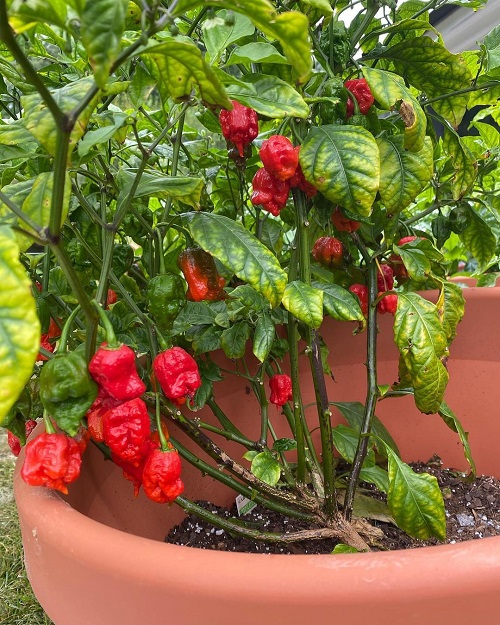
Sunlight
- Full Sun: The Carolina Reaper plant demands a full sun environment, requiring a minimum of 6-8 hours of direct sunlight each day for optimal growth.
- Morning Sun: Morning sunlight is especially beneficial as it helps dry morning dew, reducing the likelihood of fungal diseases.
- Late Afternoon Shade: In extremely hot climates, some late afternoon shade can be beneficial to reduce stress on the plant.
Soil
- Garden Soil or Topsoil: Acts as the base and provides essential nutrients. Use around 40% of topsoil in your mix.
- Compost: Adds organic matter and vital nutrients to the soil. Use about 30% compost in the mixture.
- Peat Moss or Coconut Coir: Helps in water retention and provides aeration. Use around 20% in your mix.
- Perlite or Vermiculite: Improves drainage and aeration. Include about 10% in your mix.
- Soil pH Optimal Range: Aim for a soil pH between 6.0 and 6.8 to ensure the plant can absorb essential nutrients effectively.
Watering
Early Growth Stage
- Consistent Moisture: Young plants need consistently moist soil.
- Frequency: In this stage, watering every 2-3 days may be necessary, depending on soil dryness.
Mature Plants
- Less Frequent: As the plant matures, reduce the watering frequency.
- Frequency: Typically, watering once a week is sufficient for mature plants.
Signs to Watch For
- Dry Soil: Water when the top 1-2 inches of soil are dry to the touch.
- Wilting: If leaves start to wilt, that’s a strong indicator the plant needs water.
Temperature
Vegetative Stage
- Daytime: Aim for temperatures between 68-90°F (20-32°C).
- Nighttime: Cooler temperatures, around 60-70°F (15-21°C), are adequate.
Flowering and Fruiting Stage
- Daytime: Temperatures should still be in the 68-90°F (20-32°C) range.
- Nighttime: Keep the temperature no lower than 60°F (15°C) to ensure the plant can still perform essential metabolic functions.
How to Grow Hawaiian Chili Pepper Plant
Carolina Reaper – Care
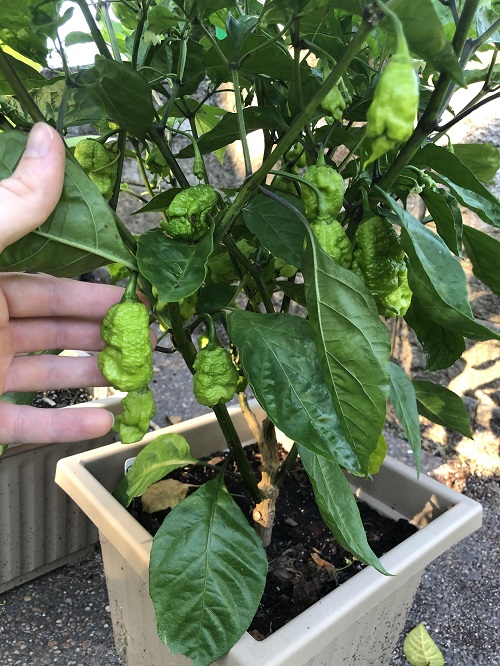
Fertilizer
Balanced Fertilizer
- N-P-K Ratio: A balanced fertilizer with an N-P-K ratio of 10-10-10 or 14-14-14 is generally recommended for the initial stages of growth.
Bloom Boosters
- High Phosphorus: During the flowering and fruiting stages, switch to a fertilizer high in phosphorus (e.g., 10-30-10).
How to Apply Fertilizer
- Granular Fertilizers: Mix granular fertilizer into the soil before planting or sprinkle it around the base of established plants. Apply it once in the growing season.
- Liquid Fertilizers: Follow the manufacturer’s guidelines for diluting liquid fertilizer. Dilute it to 1/2 of the recommended strength. Apply it every 4-6 weeks, but adjust according to the plant’s response and growth rate.
Pests
- Aphids
Tiny, soft-bodied insects that suck plant sap.
Control: Use insecticidal soap or neem oil spray.
- Spider Mites
Microscopic pests that also suck plant juices, often found on the undersides of leaves.
Control: Introduce natural predators like ladybugs, or use a miticide as a last resort.
- Thrips
Small, winged insects causing leaf distortion.
Control: Apply insecticidal soap or pyrethrin-based insecticides.
- Cutworms
Larvae that cut young plants at the soil level.
Control: Place a cardboard collar around the plant stem or use insecticides labeled effective against cutworms.
Diseases
- Root Rot
Symptoms: Wilted leaves and a rotting smell from the soil.
Control: Improve drainage and treat with fungicides that target root rot.
- Powdery Mildew
Symptoms: White, powdery substance on leaves.
Control: Use fungicidal sprays and ensure good air circulation.
- Blossom End Rot
Symptoms: Dark, sunken spots at the blossom end of the fruit.
Control: Maintain consistent watering and consider adding calcium to the soil.
- Fusarium Wilt
Symptoms: Yellow leaves and wilting despite adequate watering.
Control: Crop rotation and soil sterilization are effective prevention measures. No effective cure exists once plants are infected.
Prevention Tips
- Regular Monitoring: Keep a close eye on your plants to catch any issues early.
- Proper Spacing: Ensure adequate spacing between plants to improve air circulation and reduce disease spread.
- Clean Tools: Always use sterilized tools to minimize disease transmission.
- Soil Quality: Use well-drained soil to reduce the risk of root diseases.
- Integrated Pest Management (IPM): Utilize both chemical and non-chemical methods for a holistic approach to pest control.
Read our Article on Panda Face Ginger Plant Care and Growing Requirements here
Harvesting Carolina Reaper Peppers
Timing of Harvest
From Seeds
- Total Time: Expect approximately 160-180 days from sowing seeds to harvest.
- Germination: 14-30 days.
- Transplant to Fruit: Approximately 70-90 days after transplanting the seedlings to your garden or pots.
From Cuttings
- Total Time: Around 120-140 days from the establishment of the cutting.
- Rooting Period: Typically 20-30 days.
- Transplant to Fruit: About 90-110 days after transplanting.
Identifying Ripe Peppers
- Color: The Carolina Reaper will generally turn from green to a deep red when fully mature. Some may have a slightly purplish hue.
- Shape: Look for the signature “tail” at the bottom of the pepper, which is indicative of a mature Reaper.
- Skin Texture: Ripe peppers have a wrinkled, slightly shiny appearance.
- Size: Full-grown Carolina Reapers are generally 2-3 inches long.
How to Harvest
Safety Precautions
- Gloves: Always wear gloves made of a material like nitrile to protect your skin from extreme heat.
- Eye Protection: Consider wearing safety glasses to avoid accidental eye contact with the pepper’s oils.
Tools Needed
- Sharp Scissors or Pruners: Make sure they are clean and sterilized.
Steps
- Inspect the Plant: Examine the plant for ripe peppers based on the identifiers above.
- Cut, Don’t Pull: Using the scissors or pruners, snip the stem of the pepper, leaving about half an inch of stem on the fruit. Pulling may damage the plant.
- Place in Container: Carefully place the harvested peppers in a container. Avoid letting them touch your clothing or skin.
Post-Harvest
- Wash Tools: Clean your tools thoroughly.
- Store Peppers: Keep the peppers in a well-ventilated area to dry if you don’t intend to use them immediately. They can also be frozen or dried for long-term storage.
Learn How to Top Pepper Plants for a Bigger Harvest here
Pro Tips to Enhance the Heat of Carolina Reaper Peppers
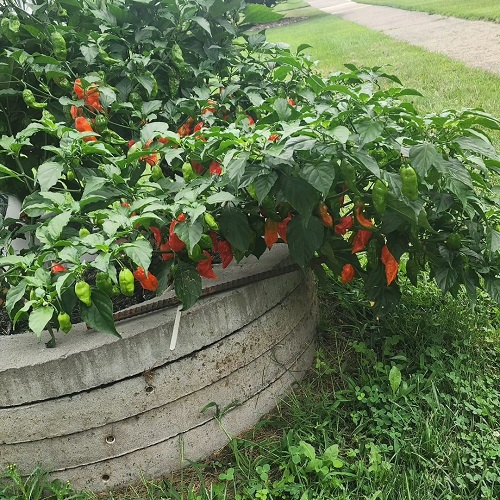
1. Controlled Water Stress
How: Allow the soil to dry out between waterings without letting the plant reach the point of wilt.
Why: Limited water access will stress the plant, stimulating the production of capsaicin.
2. Temperature Stress
How: Expose the plant to minor temperature fluctuations, a few degrees higher or lower than its optimal growth range.
Why: The stress from temperature changes can trigger an increase in capsaicin levels.
3. Nutrient Control
How: Reduce the levels of nitrogen in the fertilizer during the fruiting stage.
Why: Excessive nitrogen can lead to lush foliage at the expense of fruit and capsaicin production.
4. Pruning
How: Prune lower branches to focus the plant’s energy on fruit production.
Why: This not only boosts overall yield but can also lead to higher capsaicin concentrations in the peppers.
5. Limit Pollination
How: Limit the number of flowers that are allowed to be pollinated on each plant.
Why: Fewer fruits mean the plant can allocate more resources to each individual fruit, increasing its heat.
6. Use of Supplements
How: Use calcium and magnesium supplements.
Why: These minerals are essential for capsaicin synthesis in the plant.
7. Stress Cycling
How: Cycle between periods of stress and optimal growth conditions in an alternating pattern.
Why: Cycling can give the plant time to recover while still producing high levels of capsaicin.
8. Harvest Timing
How: Harvest peppers when they are fully mature.
Why: Capsaicin levels peak at full maturity, making late-harvest peppers hotter.
Read our article on Secrets to Grow Best Pepper Plants here
Where to Buy Carolina Reaper Plants
Online Retailers
- Amazon: Offers a variety of sellers providing both seeds and young plants.
- Etsy: A good source for small-scale, specialized growers.
- Pepper Joe’s: Specializes in hot peppers, including the Carolina Reaper.
- Bonnie Plants: Offers a variety of vegetable and herb plants, including the Carolina Reaper.
- eBay: An alternative where you can find both plants and seeds from various sellers.
Local Garden Centers
- Specialized Nurseries: Nurseries focusing on hot peppers may offer Carolina Reaper plants.
- Big-Box Retailers: Stores like Lowe’s and Home Depot often carry a variety of pepper plants, including hot varieties.
- Farmers Markets: Local growers might offer Carolina Reaper plants, especially during planting season.
FAQs About Carolina Reaper Peppers
Q 1. Are Carolina Reapers healthy to eat?
Answer: While the capsaicin in Carolina Reapers may have potential health benefits like boosting metabolism and pain relief, they should be consumed in moderation due to their extreme heat.
Q 2: Can I grow Carolina Reaper peppers at home?
Answer: Yes, you can grow Carolina Reapers at home. They require warm conditions, well-draining soil, and proper care. Starting from seeds and providing ample sunlight are key to successful cultivation.
Types of Ornamental Pepper Varieties
Q 3: How do I manage the intense heat when cooking with Carolina Reapers?
Answer: Use Carolina Reapers sparingly. Consider blending them with milder ingredients or adding small amounts at a time until you achieve the desired level of heat in your dish.
Q 4. Can I preserve Carolina Reaper peppers?
Answer: Yes, you can preserve Carolina Reapers by drying them or turning them into powders or flakes. Preserved peppers can be used to season dishes over an extended period.

